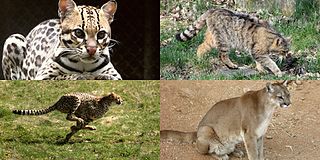Related Research Articles

François Auguste Péron was a French naturalist and explorer.

The Felinae are a subfamily of the family Felidae. This subfamily comprises the small cats having a bony hyoid, because of which they are able to purr but not roar.
Balearites is an extinct ancyloceratin genus included in the family Crioceratitidae, subclass Ammonoidea, from the Upper Hauterivian.

Coralliophila monodonta is a species of sea snail, a marine gastropod mollusk in the family Muricidae, the murex snails or rock snails.

Stoycho Vassilev Breskovski was a Bulgarian paleontologist.
This list, 2012 in molluscan paleontology, is a list of new taxa of ammonites and other fossil cephalopods, as well as fossil gastropods and bivalves that have been described during the year 2012.

Crioceratitidae is an extinct cephalopod family belonging to the subclass Ammonoidea and included in the order Ammonitida.
Jean-Gabriel Prêtre was a Swiss-French natural history painter who illustrated birds, mammals and reptiles in a large number of books. Several species of animal were named after him.
Ropoloceras is an extinct ancyloceratin genus included in the family Crioceratitidae, subclass Ammonoidea, from the Upper Hauterivian. Fossils belonging to this genera were found on localities that are now in Switzerland, France and Spain.
Damaisiceras is an extinct monospecific ancylocerid genus included in the family Crioceratitidae, subclass Ammonoidea, from the Upper Hauterivian, zone of Balearites balearis. Fossils belonging to this genera were found southeastern France.
Schaffhauseria is a genus of ammonite from the Upper Hauterivian. Its fossils have been found in Switzerland and France.
Liautaudia is monospecific genus of ammonite from the Upper Hauterivian. Its fossils have been found in Switzerland and France.
Garroniceras is genus of ammonite from the Upper Hauterivian, zones of Balearites balearis to Spathicrioceras seitzi.
Bastelia is genus of ammonite from the Upper Hauterivian, during Balearites mortilleti zone and possibly also Pseudothurmannia angulicostata zone. Its fossils have been found in Switzerland and France.
Amorina is genus of ammonite from the Upper Hauterivian, zone of Pseudothurmannia angulicostata to lower Lower Barremian zone of Coronites darsi. It has probably evolved from Megacrioceratinae and gave rise to genus Mascarellina.

Sapindoideae is a subfamily of flowering plants in the soapberry family, Sapindaceae.
Dendrobium affine, commonly known as the white butterfly orchid, malakmalak or matngala in Australian Aboriginal languages is an epiphytic orchid in the family Orchidaceae. It has cylindrical pseudobulbs, each with up to ten leaves and flowering stems with up to twenty white flowers with yellow or purple markings on the labellum. It occurs in northern Australia, New Guinea and Timor, where it grows on the bark of trees.

Sander Rang or Paul Charles Leonard Alexander Rang was a French conchologist and interpreter of Arabic texts. He was, in 1816, one of the survivors of the sinking of the frigate Medusa, on which he was an ensign. He spent a good part of his life in La Rochelle, where he published his early zoological observations, in particular in the bulletins of the Society of Natural Sciences of Charente-Maritimes.In 1841 Rang was one of the founding members of the Société des Amis des Arts now the Musée des Beaux-Arts de La Rochelle.He specialised in marine fauna notably in sea hares, cephalopods and other molluscs and on the heterogenous group known as zoophytes. Sander Rang described many new mollusc species including the sea hares Aplysia dactylomela, Dolabrifera dolabrifera, the cuttlefish Sepia hierredda and the land snails Striosubulina striatella, Pleurodonte desidens and Opeas hannense.
References
- 1 2 Vermeulen, J. E. A. N. "Nouvelle classification à fondement phylogénétique des ammonites hétéromorphes du Crétacé inférieur." Annales du Musé um d’Histoire Naturelle de Nice 21 (2006): 137-178.
- ↑ Vermeulen J. & Meister C. 2014. Nouvelles espèces du genre Garroniceras Vermeulen et al., 2012 (Ammonitida, Hamulinoidea, Hamulinidae, Megacrioceratinae). Riviera Scientifique 98: 73-90.
- ↑ Vermeulen (J.), Lazarin (P.), Lépinay (P.), Leroy (L.), Mascarelli (E.), Meister (C.) & Menkveld-Gfeller (U.), 2012 - Ammonites (Ancyloceratina, Turrilitina) nouvelles ou peu connues de l'Hauterivien supérieur. Annales du Museum d'Histoire Naturelle de Nice, t. 27, p. 271-318